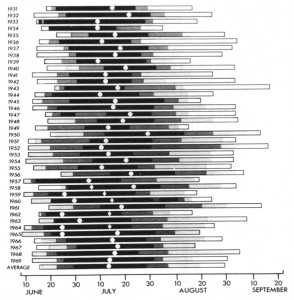
June proved to be very warm and relatively dry with 2.6″ of rainfall over 30 days. Over the past ten days of July the Hudson Valley received significant amounts of much needed rainfall. At the HVRL in Highland over 1.83″ of rain fell since the start of July, providing ample moisture for the apple maggot adult fly, Rhagoletis pomonella, to emerge from the soil. In this mornings scouting report we had captured an average 2.0 adults per trap over the weekend with one block above threshold at 5 flies per trap. Each orchard should have traps out to determine AM pressure in early maturing varieties such as Ginger Gold.
Red sphere traps are very attractive to mature adult female AM flies, ready to oviposit. Through the development of the red sticky sphere and attractive lures using ammonium acetate, butyl hexanoate (fruit odor) ammonium carbonate (food odor), or blends, the trigger for apple maggot management can be postponed until mature flies capable of laying viable eggs are captured in traps. When placed along wooded edges and abandoned blocks in commercial apple, traps can provide optimum timing for management of early maturing, highly attractive varieties such as Ginger Gold, using a threshold of 5 flies per trap.
P.J. Chapman and R. Dean found dramatic variability of AM emergence from season to season. There is considerable variability between farms with infestation levels differing between farms based on a number of variables. These include weather, soil moisture and site, with apple variety preference of early egg laying puncture of fruit coinciding with varietal maturity. Evaluations of apple maggot emergence from 1931 to 1969 in Hudson Valley Orchards showed that in 31% of the years monitored for emergence, AM emerged beyond the 20th of August. Yet there was little or no emergence of new flies after the 1st of September. This reassured apple producers that applications beyond the 15th of August were not needed AS LONG AS effective reside was present up to the 1st of September. In 1973 (the year of R. W. Dean and P.J. Chapman’s publication) the organophosphates such as Imidan and Guthion were the insecticides of choice in managing AM.


One of the challenges we face today is the lack of residual efficacy of newer insecticides to actually kill the AM fly. This may not be as important as one might think. Generally, the neonicotinoids prevent the fly from laying eggs into the fruit, yet they produce lower levels of mortality of the fly, allowing adult AM to be present in the orchard late into the season. If there is significant rainfall there is often a reduction in residual activity that may lead to AM punctures with few or no eggs present in the sting or puncture of the apple.
The bottom line is that traditional IPM based use of the baited red sticky sphere, which has been successful at monitoring the onset of AM emergence and treatment threshold, is not a strong tool for use in signaling reapplication. Once AM spheres have been ‘reset’ (cleaned), AM flies may reach the 5 fly per trap threshold more quickly using neonicotinoids that have high egg laying deterrence but low adult toxicity. Instead, the use of neonicotinoids such as Actara and to a lesser degree Assail, will need to be applied at a 10-14 day window despite high trap captures immediately after orchard treatments into September.
Assail is a very effective insecticide at managing the AM fly, and has a great fit for the onset of 2nd generation Codling moth. In general Assail has excellent efficacy against the internal lepidopteran complex such as OFM late into the season.
To drive this point home, in page 9 of a presentation by Dr. H. Reissig in 2010, Harvey confirmed the ability of AM to ‘sting’ fruit yet produce very few eggs employing many old and new insecticides against the AM. In this comparative study, he demonstrated the efficacy of Assail and Guthion to be about equal in control of AM tunneling from larva. Additional studies by Jentsch reinforce these findings, shown in 2006 field efficacy studies conduced at the Hudson Valley Lab research orchard.

